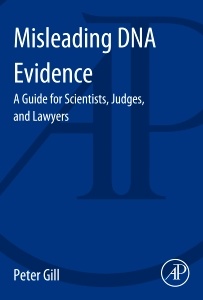Description
Misleading DNA Evidence
Reasons for Miscarriages of Justice
Author: Gill Peter
Language: English
Subject for Misleading DNA Evidence:
100 p. · 15.2x22.8 cm · Paperback
Description
/li>Contents
/li>Readership
/li>Biography
/li>Comment
/li>
Misleading DNA Evidence: A Guide for Scientists, Judges, and Lawyers presents the reasons miscarriages of justice can occur when dealing with DNA, what the role of the forensic scientist is throughout the process, and how judges and lawyers can educate themselves about all of the possibilities to consider when dealing with cases that involve DNA evidence.
DNA has become the gold standard by which a person can be placed at the scene of a crime, and the past decade has seen great advances in this powerful crime solving tool. But the statistics that analysts can attach to DNA evidence often vary, and in some cases the statistical weight assigned to that match, can vary enormously. The numbers provided to juries often overstate the evidence, and can result in a wrongful conviction. In addition to statistics, the way the evidence is collected, stored and analyzed can also result in a wrongful conviction due to contamination.
This book reviews high-profile and somewhat contentious cases to illustrate these points, including the death of Meredith Kercher. It examines crucial topics such as characterization of errors and determination of error rates, reporting DNA profiles and the source and sub-source levels, and the essentials of statement writing. It is a concise, readable resource that will help not only scientists, but legal professionals with limited scientific backgrounds, to understand the intricacies of DNA use in the justice system.
- Ideal reference for scientists and for those without extensive scientific backgrounds
- Written by one of the pioneers in forensic DNA typing and interpretation of DNA profiling results
- Ideal format for travel, court environments, or wherever easy access to reference material is vital
Preface
Chapter 1: Definitions: Contamination and Interpretation
Chapter 2: A Deep Analysis of the Basic Causes of Interpretation Errors
Chapter 3: A Framework to Interpret “Trace-DNA Evidence Transfer
Chapter 4: National DNA Databases, Strength of Evidence and Error Rates
Chapter 5: Concluding Remarks: Illustrated by the Case of the Death of Merdith Kercher
Glossary
Bibliography
Index
History
I joined the Forensic Science Service (FSS) in 1982. I began research into DNA in 1985, collaborating with Sir Alec Jeffreys of Leicester University. In the same year we published the first demonstration of the forensic application of DNA profiling. In 1987 I was given an award under the civil service inventor’s scheme for my discovery of the preferential sperm DNA extraction technique and the development of associated forensic tests. I was employed as Principal Research Scientist at the Forensic Science Service (FSS). This was the highest scientific grade within the FSS. I am professor of Forensic Genetics and I hold concurrent positions at the Norwegian Institute of Public Health and the University of Oslo.
Romanovs
In 1993-4 I was responsible for leading the team which confirmed the identity of the remains of the Romanov family, murdered in 1918, and also the subsequent investigation which disproved the claim of Anna Anderson to be the Duchess Anastasia (using tissue preserved in a paraffin wax block for several decades). This was the first example in the world of the solving of an historical mystery that involved the analysis of very degraded and aged material, and was one of the first demonstrations of low-template DNA analysis.
Low-template DNA
In relation to the above, I was responsible for developing a ‘super-sensitive’ method of DNA profiling that is capable of analysing DNA profiles from a handful of cells. This method was originally known as low-copy-number (LCN) DNA profiling. Now it is known as Low template DNA profiling. New statistical methods and thinking were also developed to facilitate the new methods. I am currently completing a book (deadline of 31st March, 2014) to be published by Elsevier that describes methods to report ‘trace-DNA’ along with the various pitfalls that are illustrated by recent miscarriages of justice.
National DNA database
I was responsible for leading the team that develo
- Ideal reference for scientists and for those without extensive scientific backgrounds
- Written by one of the pioneers in forensic DNA typing and interpretation of DNA profiling results
- Ideal format for travel, court environments, or wherever easy access to reference material is vital




